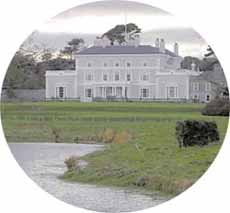
| the Ballywalter
house, like many other grand houses, suffered some deterioration as the twentieth century sped forwards. The third Lord Dunleath, Charles Mulholland, saw the world go through the wars and move away from the days of the great houses with an army of servants. He described the house he left his son, Henry, as a Victorian white elephant with a monstrosity of a conservatory stuck on to one end of it.' A visit to the house by Sir John Betjeman became a real turning point. The poet laureate was ecstatic about its architect, commenting that the conservatory, rather than being a 'monstrosity', was an essential element in Lanyon's concept for the rear elevation and should be preserved at all costs. He was of the opinion that if the entire house could be preserved as originally designed, it would become a mecca for architectural historians and enthusiasts. Following this, Henry, the fourth Lord Dunleath and his wife, Dorinda, began the painstaking and expensive task of preserving the family home that is a monument to Ulster's past. The conservatory and the porte cochère were the first items to be restored and the work advanced from there. After Henry's death in 1994, however, everything came to a standstill, so that when Brian took over the house in 1997, there was still a very great deal to be done. "I initiated my work on the house, which incidentally is the seventeenth phase of the restoration work, by engaging Alastair Coey, the Belfast-based conservation |
 |
dereliction,
to provide a small dining room for our everyday use. On the first floor we installed additional bathrooms, to give eight bedrooms and six bathrooms on that floor and we reopened the second floor, which was the nursery floor and had been unused since before the Second World War. That was a very big job, and involved bringing heat, light and power to the upper floor. We have finished up with five en-suite double rooms and one single room with a fantastic shower room on that floor." Despite such an extensive programme, the renovation work is not yet complete. The next phase will see the restoration of the billiard room and smoking room, which were damaged by a near disastrous fire in the mid 1970's and, ultimately, Brian would like to remove the remainder of the north section of the house, known as the cricket wing. "This was a later addition to the house," he explained, "and is not in keeping with the original work undertaken by Sir Charles Lanyon." Looking to the future The renovation of Ballywalter Park has been a huge project, and undoubtedly a house of its grand proportions will need constant care and attention to maintain. Brian's great uncle, Charles Dunleath, found it difficult to envisage a future for Ballywalter without the proper complement of staff, yet Brian and his partner, Vibse, a Danish born food historian, maintain the house with Debbie, the gamekeeper, Gordon's wife, to help out. |
||||
|
architect, to carry out a full survey |
||||||
|
Countrysports
and Country Life Summer 2002
|
|
| << Previous | |